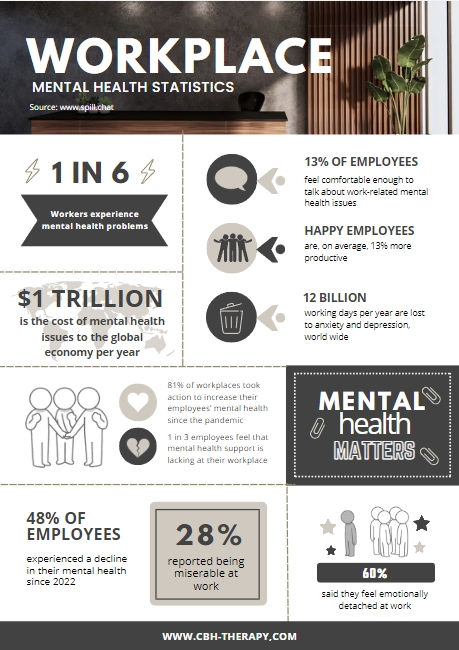For a long time, the mental wellbeing of an employee was regarded as his or her own responsibility. Times have changed, with more and more employers starting to take mental health problems seriously and into their own hands. In this article, I would like to discuss why mental health in the workplace matters.

The Connection Between Mental Health and Work
A full-time employee spends at least 40 hours a week working. Whether in an actual office or in a remote position from home, that is a significant amount of time. The workplace often blends with our lives outside of work, with colleagues becoming friends and new technologies reminding us of our duties outside office hours. What happens at work doesn't stay at work.
The workplace has an increasing impact on our mental wellbeing. In turn, mental health issues have an impact on our work. Recent statistics about mental health in the workplace show that, among other findings:
1 in 6 employees experience mental health issues related to work (Source: Mental Health Foundation)
Full-time female workers are almost twice as likely to suffer from mental health disorders as their male counterparts (Source: Mental Health Foundation)
The costs of employees leaving due to work-related mental health issues have increased by more than 150% in the last three years (Source: Deloitte)
The global cost of mental health issues to the economy stands at around $1 trillion USD per year (Source: WMHI)
The Causes of Work-Related Mental Health Issues
It can easily be said that the workplace has become a major source of a mental health pandemic. If we want to explore the causes of workplace-related mental disorders, the World Health Organization states the following:
Boredom (skills not being used or underused)
Stress (excessive workload, long hours, lack of control, etc.)
Issues related to physical safety at work
Unhealthy work culture (bullying, limited support, harassment, discrimination, etc.)
Job roles that aren't clearly defined
Job insecurity, underpayment
Conflict between work and life, lack of work-life balance
The Impact of Mental Health Disorders on the Workplace
Each of these causes, whether on their own or in combination, can lead to stress, anxiety, and/or depression—the leading mental health issues in the workplace—ultimately resulting in burnout or even suicide. This, in turn, has the following consequences for companies:
Loss of productivity (Source: de Oliveira et al.)
Increase in sick leave (Source: Deloitte)
High turnover of employees (Source: TechTarget)
It’s no wonder that employers and employees are now facing the challenges of work-related mental health issues together.

How to Promote Mental Health Wellbeing at Work
The workplace is more than just a place you go to get paid. It is a place where people meet, ideas are exchanged, and ideally, the outcomes benefit humanity. The evaluation of health promotion measures should, therefore, be based on eliminating the causes mentioned above.
Step 1: Eliminate Causes
Creating a workplace environment free of unnecessary stressors, with a genuinely positive work culture and healthy working conditions, allows employees not only to achieve their goals safely but also to learn and grow. This is the first step to better mental health at work.
The Department of Health and Safety can help reduce illnesses caused by accidents.
Human Resources can implement policies for employers to address bullying, discrimination, and other behaviours that negatively impact mental health, both safely and effectively.
External business organisations can provide guidance on adequate pay and role definitions.
Job security can be improved through better and longer-term planning by company directors.
Step 2: Provide Further Assistance
Certain types of employee stress cannot be eliminated; they are part of our everyday lives, in and outside work environments. By implementing wellbeing strategies, workers can be supported in dealing with these kinds of stressors. Mental health organisations can be hired to teach coping strategies to employees.
Initiatives can also include group therapy or access to therapists, allowing workers to book one-on-one sessions free of charge or at a reduced price.
The importance of employee growth can be addressed by collaborating with adult education organisations. They can provide learning opportunities and certificates directly linked to the current or future roles the employee is interested in. This will promote career development, a sense of purpose, and the feeling of being valued by the company.
Step 3: A Continuous Wellbeing Strategy
Implementing the second step while ignoring the first or parts of it will lead to the organisation spending money without seeing the desired effects. Positive change cannot be achieved by taking shortcuts.
This also means that once the mental health improvement strategies are in place, continuous evaluation is required. What works and what doesn’t for your staff? Experiences and case studies show that open communication, without the fear of what has been said being used against an employee, helps create a positive work environment. Ultimately, it is the people who work for a company who know what is required to improve their workplace.
Should you wish to provide your employees with access to a therapist, my experience as a cognitive behavioural hypnotherapist specialising in work-related stress and pain management could be exactly what you are looking for. Please do not hesitate to get in touch.
FAQs
What are the most common mental health issues in the workplace?
Stress, anxiety, and depression are the most common mental health disorders in the workplace. If left unaddressed, they can result in burnout and/or suicide.
What should I do when my job is affecting my mental health?
Seek help! Whether it’s speaking to your supervisor or a therapist, you do not have to suffer through this on your own. If your work environment allows for an honest conversation with your boss, they will surely be happy to help you. A therapist can provide you with techniques to help you deal with stress better and/or gain a more positive outlook on life.
How does mental health affect the workplace?
Mental health disorders have various effects on the workplace, including reduced productivity and increased sick leave. Companies benefit from creating an environment that supports mental health and the overall wellbeing of their staff.